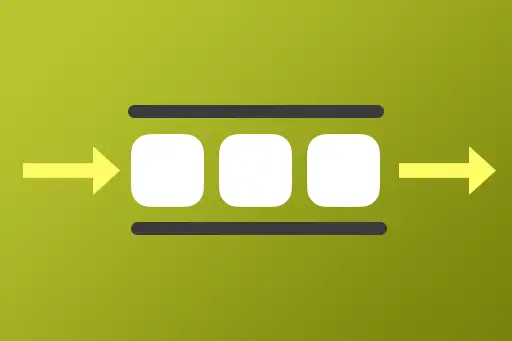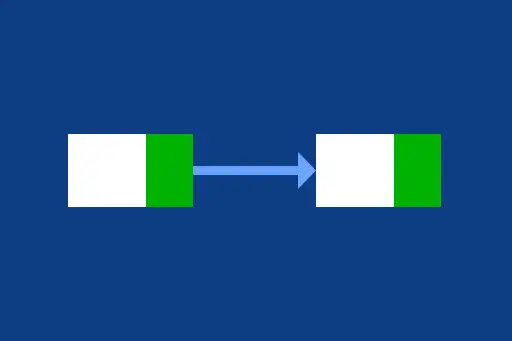- 1Singly Linked List Introduction
- 2Singly Linked List – Create Operation
- 3Singly Linked List – Insert Operation
- 4Singly Linked List – Delete Operation
- 5Singly Linked List – Traversal Operation
- 6Singly Linked List – Search Operation
- 7Singly Linked List – Get Length Operation
- 8Singly Linked List – Reverse Operation
- 9Doubly Linked List Introduction
- 10Doubly Linked List – Create Operation
- 11Doubly Linked List – Insert Operation
- 12Doubly Linked List – Delete Operation
- 13Doubly Linked List – Traversal Operation
- 14Doubly Linked List – Search Operation
- 15Doubly Linked List – Get Length Operation
- 16Doubly Linked List – Reverse Operation
Singly Linked List – Delete Operation
Visualization Player
Delete Operation in Singly Linked List
After deleting node at index/position = 2.
Deleting from a singly linked list means removing a node from a specific position. We adjust the next pointer of the previous node to skip the node being deleted.
This operation can be done at the beginning, in the middle, or at the end of the list depending on the index.
Visual Example
Suppose we have a list:
We want to delete the node at index 2 (value 30), so the final list becomes: 10 → 20 → 40 → null
Step-by-Step Deletion at Index 2
- Start with list
10 → 20 → 30 → 40 → null. - Traverse to node at index
1(value20). - Set
current.next = current.next.next(i.e., 20 skips 30 and points to 40). - The node with value
30is now disconnected and will be garbage collected.
Complete Pseudocode: Delete Node in Singly Linked List
This pseudocode shows how to delete a node at a specific index in a singly linked list.
function deleteAt(head, index):
if index == 0:
return head.next
curr = head
for i in range(index - 1):
curr = curr.next
if curr.next is not null:
curr.next = curr.next.next
return headLet’s walk through each part of the code to understand what it does.
function deleteAt(head, index):Explanation: The function is defined to delete a node at the given index from the singly linked list.
if index == 0:
return head.nextExplanation: If the index is 0, it means the head node should be deleted. We return head.next, which becomes the new head of the list.
curr = head
for i in range(index - 1):
curr = curr.nextExplanation: For deletion at other positions, we first move curr to the node just before the one we want to delete by looping index - 1 times.
if curr.next is not null:
curr.next = curr.next.nextExplanation: This ensures we’re not at the end of the list. If the next node exists, we skip it by pointing curr.next to curr.next.next, effectively deleting the target node.
return headExplanation: We return the original head so the caller can continue to use the updated list.
Singly Linked List Delete Operation Examples
The following examples demonstrate how to delete a node from various positions in a singly linked list.
| Initial List | Delete Index | Final Linked List | Explanation |
|---|---|---|---|
| [10, 20, 30]
|
0 | 20 → 30 → null | Delete at the beginning. Head node is removed. New head is the next node. |
| [10, 20, 30] | 1 | 10 → 30 → null
|
Delete from the middle. Node at index 1 (value 20) is skipped by adjusting the next pointer of the previous node. |
| [10, 20, 30]
|
2 | 10 → 20 → null
|
Delete at the end. Tail node (value 30) is removed. New tail points to null. |
| [10, 20, 30]
|
5 | Error | Invalid index. The index is greater than the list size. Most implementations will throw an error or return failure. |
Time Complexity of Singly Linked List Delete Operation
| Deletion Case | Time Complexity | Explanation |
|---|---|---|
| Delete at Beginning | O(1) | We update the head pointer to point to the next node. No traversal is needed. |
| Delete at Middle | O(n) | We must traverse the list to find the node just before the one to delete. This requires linear time. |
| Delete at End | O(n) | We must traverse to the second-last node to update its next pointer to null. |
| Delete by Value | O(n) | We traverse to find the first node with the target value, which may require scanning the whole list. |
Space Complexity of Singly Linked List Delete Operation
| Deletion Case | Space Complexity | Explanation |
|---|---|---|
| Delete at Beginning | O(1) | No extra memory is used. Only the head pointer is updated. |
| Delete at Middle | O(1) | No extra space is needed; the node is removed by pointer reassignment. |
| Delete at End | O(1) | Even though traversal takes time, no additional space is required to perform deletion. |
| Delete by Value | O(1) | Space remains constant regardless of position of value. |
Key Concepts
- Head deletion: Simply move the
headpointer tohead.next. - Middle deletion: Traverse to (index - 1), skip the node to be deleted by updating the
nextpointer. - Tail deletion: Traverse to second-last node and set its
nexttonull. - Delete by value: Search for node with the given value, update previous node’s
next. - Always check if the list is empty before deleting and handle edge cases like single-node lists.
Next Topic ⮕Singly Linked List – Traversal Operation






Comments
Loading comments...